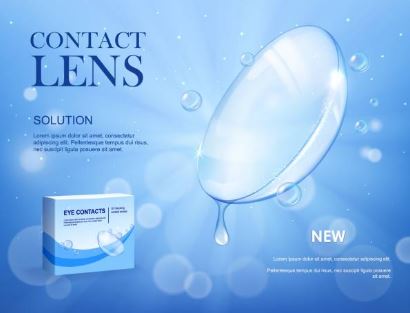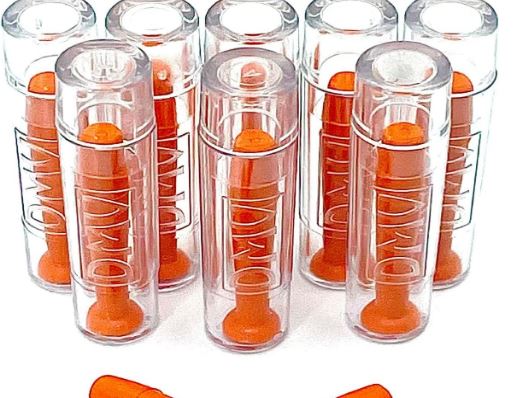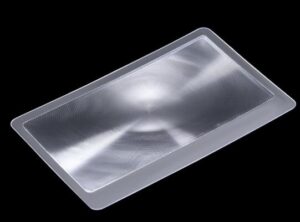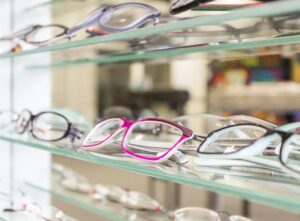Scleral lenses have been a hot topic in the contact lens community for the past few years. National conferences are held specifically to teach people how to correctly fit these specialized contact lenses. Continue reading, and you will learn how the scleral lenses work, and things you should care about when you wear scleral lenses.
Table of Contents
What Are Scleral Lenses?
There are two main categories of contact lenses: hard and soft. In many cases, hard lenses are gas-permeable, allowing oxygen to reach your cornea. Soft contact lenses are smaller than scleral lenses. They rest on the sclera surrounding the cornea and are firm, holding their shape.
Scleral contact lenses are used to treat refractive errors that lead to vision problems, just like other contact lenses. They can correct:
- Nearsightedness (myopia)
- Farsightedness (hyperopia)
- Distorted vision (astigmatism)
- Difficulty with near vision with age (presbyopia)
Gas-permeable material is used to create scleral contacts. They let oxygen reach your cornea. If your corneas have an abnormal shape, such as from keratoconus or astigmatism, scleral lenses can be helpful. Following LASIK (laser in-situ keratomileusis), a procedure to correct refractive errors or corneal transplants, you can also use scleral lenses. A reservoir of saline solution is filled in the space between the scleral lens and the eye. For those who have dry eyes, scleral lenses are comfortable.
What is Scleral Lens Used For?
Scleral lenses are a valuable therapeutic tool for patients with ocular surface disease as they protect the ocular surface, provide continuous corneal hydration while providing optimal visual correction, and can be used in conjunction with other therapies. Fitting scleral lenses have no age restrictions.
Why Scleral Lenses Work?
The concept of placing a dome over the eye to enhance vision and eye health is credited to Leonardo da Vinci. The first scleral contact lens, however, wasn’t made until 1888 by a German ophthalmologist. Today, soft contact lenses have dominated the market. Soft contact lenses may not be comfortable for many patients, especially those with irregular corneas or those who have undergone surgery.
The scleral lens neutralizes corneal irregularities while promoting healing and hydration of the ocular surface because it does not directly contact the cornea but instead forms a dome over it and rests on the sclera or the white part of the eye. The eye is kept lubricated without being obscured by a preservative-free saline solution that is contained inside the lens’ bowl. It offers your eye a cozy environment for recovery while ensuring sharp vision and security from outside influences. Scleral lenses can also enhance the quality of your life because of the comfortable wear that comes with their custom fit over your eye.
What Are the Disadvantages of Scleral Contact Lenses?
For those who cannot use other types, scleral lenses are useful. But they have a few disadvantages:
- Not all ophthalmologists and optometrists offer these services. Specialized training is required for these lenses.
- Scleral lenses cost between four and five times as much as soft contacts. They can, however, be used for much longer.
- Scleral lenses frequently accumulate debris and require cleaning throughout the day.
- Sometimes they lose their place.
- After using soft lenses, it can be challenging to adjust to scleral lenses.
Who Can/should Wear a Scleral Lens?
Scleral lenses can technically be worn by any patient. However, patients with corneal diseases, dystrophies, and degenerations (i.e. keratoconus), patients who have corneal scars and irregularities, and patients who have had a corneal transplant or refractive surgery (i.e. The corneas of all of these patients have been altered in some way, whether through LASIK or RK. Vision will be poor with both glasses and conventional contact lenses if the cornea does not have a perfect convex or dome shape. In what ways can a scleral lens benefit these patients, then? The cornea and the scleral lens are separated by a reservoir of fluid. Each irregularity in the cornea is filled in by this reservoir, which also produces a surface that is perfectly round. And suddenly, the majority of patients claim to have their clearest vision in memory!
What is the Contact Solution for Scleral Lenses?
Use only solutions designed specifically for storing and caring for contact lenses. Never clean your contact lenses with water or any sort of detergent solution. Cleaning and sterilizing your scleral contact lenses is possible with a multipurpose contact lens solution. Your lenses will be conditioned with these solutions. Every three months, you ought to swap out your storage container.

Hydrogen peroxide is an ingredient in other lens-cleaning solutions. Additionally cleaning and sanitizing your lenses, these solutions. Additionally, they release and remove fatty, protein, and trapped debris. Your eyes could be harmed by hydrogen peroxide. To make it safe to put your contact lenses in your eyes, you must use a neutralizer. In all cases, kits for cleaning lenses with hydrogen peroxide come with a neutralizer. For at least six hours, let your contact lenses soak in the neutralizer solution.
Why Opt for Scleral Lenses?
Exactly why do you wear contact lenses? Correct refractive error or astigmatism and enhanced vision is typically the first motivation. Soft lenses are also chosen for aesthetic and practical purposes, such as avoiding glasses during activities or sports. Just as important as vision is comfort when wearing contact lenses, if not more so. For us, comfort entails a custom fit of oxygen-permeable lenses over the cornea that keep your eye hydrated while allowing oxygen to pass through to either treat your eye or offer day-to-day comfort.
How Do You Put in Scleral Contact Lenses?
Scleral lenses are implanted using a different technique than soft lenses. Your scleral lenses have a reservoir to store fluid and keep your cornea moist. These steps are needed:
- Use soap and water to thoroughly wash your hands.
- A preservative-free saline solution should be filled the lens well. Your cornea may be harmed by preservatives.
- Check the lenses for bubbles, as these will cause vision blur.
- Put the lens in your eye using the three-finger tripod technique once the lens well is full.
How Long Can You Wear Scleral Lenses?
Many patients who wear scleral lenses are able to wear them for 12-14 hours daily. To maintain the best vision and comfort throughout the day, some patients may need to remove the lenses, clean them, and reapply them with fresh saline on occasion.
What Are the Do’s of Scleral Contact Lens Wear?
Good Hygiene Is Key
Before handling your contact lenses, always wash and completely dry your hands. In order to avoid eye infections and other complications, proper hygiene is crucial. Keep your scleral lenses clean and free of debris by performing routine cleanings. The clarity of your contacts may be impacted by buildups, so keep that in mind. Rub your contacts with the appropriate lens cleaner for a brief period of time after removing them to remove debris and bacteria. Before putting the lenses away, rinse both sides with saline solution.
Use Cotton Swabs for Cleaning
If you have long fingernails, cleaning scleral lenses may be more challenging. Instead of using your fingers, you can use a cotton swab. Rub a cleaning solution with a cotton swab to remove any buildup from the lens’ interior bowl. To get rid of any leftover cleaning solution and cotton swab lint after cleaning the lenses, give them a saline rinse.
Address Dry Eyes
Even though scleral contact lenses can help with symptoms of dry eye, you should still treat the eye condition. The condition of dry eyes is not treated by scleral lenses, but they do help manage it. For advice on the best course of action for you, consult an eye doctor. To assist with lubricating your eyes, they might suggest medications or eye drops.
Use Insertion Tools
Use a different insertion technique or tool if you’re having problems with your current one. The equipment you should use for your scleral lenses can be recommended by your ophthalmologist. Always use the tools that your eye doctor recommends.
See Your Eye Doctor Regularly
You’ll need to visit your eye doctor frequently to ensure that your scleral lenses are fitting properly because they are custom-made. You can monitor the state of your lenses by making subsequent trips to your eye doctor. If your lenses are bothering you or causing you problems, you should let them know.
What Are the Don’ts of Wearing These Lenses?
Using a Different Solution Than What’s Recommended by Your Eye Doctor
Whatever type of contact lenses you have, you should never use a solution that hasn’t been approved by your eye doctor. The cleaning and storing of contacts should not be done with running water, saliva, or other liquids. They contain microbes that can damage your eyes.
If you don’t clean your lenses with the right solution, you might experience eye symptoms like redness or the impression that something is in your eye. Once present, these symptoms typically don’t go away and eventually lead to infection. Then, you’ll need to get assistance from your eye doctor.
For the medication to start working and your eyes to make a full recovery, it can occasionally take up to a few weeks. You won’t be able to use your contact lenses in the interim. It might be difficult for you to carry out daily tasks like working, reading, driving, and cooking while you’re receiving this treatment.
Wearing Scleral Lenses for Too Long
Scleral lenses can be worn continuously by people with keratoconus. It’s important to properly lubricate your contacts when wearing them for prolonged periods of time to prevent overwear. Infection, irritability, and inflammation can be caused by inadequate lubrication. Ask your eye doctors if they can recommend any high-quality artificial tears. When you run out of eye drops while traveling, look for non-preservative products.
Sleeping With Your Scleral Lenses On

Sleeping with your contacts in is not advised by experts. Your eyes shed tears when you blink, washing away dirt, dust, bacteria, proteins, allergens, and other particles. If you sleep with your scleral lenses on, since you are not blinking while you are asleep, these dangerous substances are more likely to gather in your eyes. Therefore, not removing your contacts before bed can result in eye inflammation or infection.
Delaying Eye Doctor Visits and Contact Lens Replacement
The significance of routine visits to your eye doctor cannot be overstated by experts. The frequency of visits to the eye doctor for people who wear scleral lenses may increase. You typically need to make appointments every four to six months if you wear this type of contact lens. Your doctor will be able to monitor your eye health, any changes to your eyes, and the effectiveness of your prescription if you consistently keep your scheduled eye exams.
What Are the Differences Between Scleral Lenses VS. Contact Lenses?
The cornea supports soft contact lenses. Most wearers find them to be comfortable because they are soft. However, people with dry eye disease, Stevens-Johnson syndrome, Sjogren’s syndrome, keratoconus (an abnormally shaped cornea), and graft-versus-host disease may find these contact lenses uncomfortable. Regular contact lenses may not be suitable for people who have undergone corneal surgery.
The cornea cannot fit scleral contact lenses. The majority range in diameter from 14 to 24 millimeters. They soar over the cornea and land on the sclera, the hard, white part of the eye. The fluid inside keeps the eyes moist for a longer period of time.
Lenses for the sclera are not new. They have long been appreciated for their benefits in terms of corneal oxygenation. They shield the cornea from hypoxic damage and might even repair existing damage.
How to Care for Your Lenses?
The health of your eyes depends on how well you take care of your contact lenses. Some important measures include:
- Before putting on or taking out your contacts, wash your hands.
- Always take off your lenses before going to bed. An eight times greater risk of infection exists when wearing contact lenses while you sleep.
- Viruses can travel in water. Avoid getting water on your lenses. Never wear them when bathing or swimming.
- Utilize a contact lens disinfecting solution to clean your lenses.
- Every three months, wash your contact lens case with the same solution and replace it.
Maintaining the health of your lenses is essential for vision. Diseases like keratitis and eye infections can be brought on by improper care. Remove your contact lenses right away and consult your doctor if you have red eyes or eye pain. The use of contact lenses increases the risk of serious eye infections, which can be blinding.
How Much Do Scleral Lenses Cost?
At Eye Society, the average cost for Scleral Lenses is $2,500 which includes the fitting. Because they are custom-fitted and may be required to help correct a number of eye issues, they are typically three to four times more expensive than regular contact lenses.
Are Sclera Lenses Painful?
Are scleral lenses painful? If they are fitted correctly, they should not hurt. In fact, if your lens is properly fitted, you’ll discover that you can keep your eyes open for a lot longer because the fluid hydrates the tissue; you’ll never lose a staring contest again.
Can You Shower With Scleral Lenses?
Can I take a shower with my lenses on? You should avoid showering with lenses because shower water is not sterile and could introduce bacteria into the lens.
What Happens If I Sleep With a Scleral Lens In?
Sleeping in your scleral lenses can cause the tear layer behind the lens to become stagnant, increasing the risk of eye infections. It is best to minimize any risk to the eye’s surface, especially considering that the majority of patients wearing scleral lenses have compromised, complicated eyes.
Conclusion
The perfect placement over the cornea, which is the scleral lens’s secret, can be made with the help of 3D modeling, printing technology, and scanning technology, respectively. So why not schedule a consultation at Weston Contact Lens Institute so that our eye doctors can determine whether scleral lenses would be a good fit for you?


